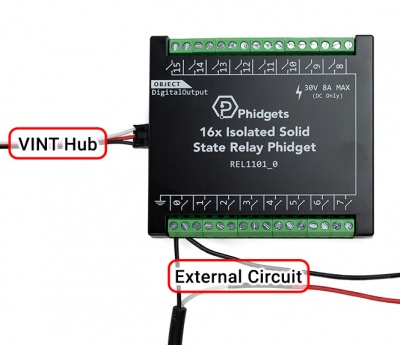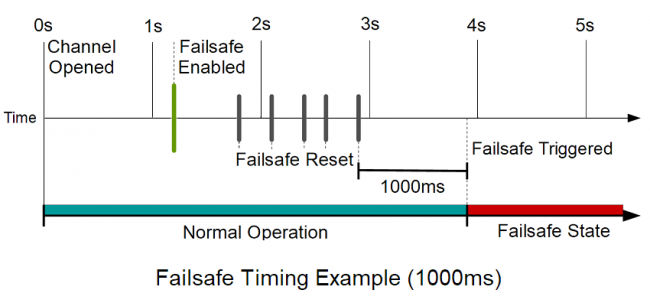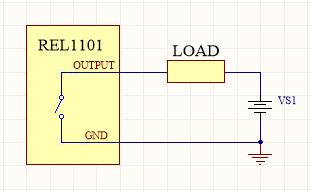Open Collector Digital Output Guide
Open collector digital outputs behave like a solid-state relay that switches a line to ground. Learn more here.

The REL1101 is a PWM-enabled solid state relay. The relay is great for controlling LED strips, DC motors, power relays, fans, and other small circuits. Solid-state relays switch silently and quickly, and last much longer than mechanical relays. This Phidget connects to your computer through a VINT Hub.
This Phidget is a smart device that must be controlled by a VINT Hub. For more information about VINT, have a look at the VINT Overview page. You can use a Phidget Cable to simply and easily connect the two devices. Here's a list of all of the different VINT Hubs currently available:
| Product | Board Properties | |||
|---|---|---|---|---|
| Part Number | Price | Number of VINT Ports | VINT Communication Speed Max | Controlled By |
 VINT Hub Phidget
|
$40.00 | 6 | 1 Mbit/s | USB (Mini-USB) |
 1-Port VINT Hub Phidget
|
$24.00 | 1 | 1 Mbit/s | USB (USB-A) |
 VINT Hub Phidget
|
$35.00 | 6 | 1 Mbit/s | USB (Mini-USB) |
 VINT Hub Phidget
|
$30.00 | 6 | 100 kbit/s | USB (Mini-USB) |
 Wireless VINT Hub
|
$60.00 | 6 | 100 kbit/s | Local Network (Ethernet or Wi-Fi) |
 PhidgetSBC4
|
$120.00 | 6 | 100 kbit/s | — |
Use a Phidget cable to connect this device to the hub. You can solder multiple cables together in order to make even longer Phidget cables, but you should be aware of the effects of having long wires in your system.
| Product | Physical Properties | |
|---|---|---|
| Part Number | Price | Cable Length |
 Phidget Cable 10cm
|
$1.50 | 100 mm |
 Phidget Cable 30cm
|
$1.75 | 300 mm |
 Phidget Cable 60cm
|
$2.00 | 600 mm |
 Phidget Cable 60cm
|
$2.00 | 600 mm |
 Phidget Cable 90cm
|
$2.00 | 900 mm |
 Phidget Cable 120cm
|
$2.25 | 1.2 m |
 Phidget Cable 150cm
|
$2.50 | 1.5 m |
 Phidget Cable 180cm
|
$2.75 | 1.8 m |
 Phidget Cable 350cm
|
$3.00 | 3.5 m |
 Phidget Cable Kit
|
$10.00 | 80 mm |
 Phidget Cable Extension Wire 22AWG
|
$0.75/Meter | — |

The REL1101 has 16 PWM-enabled solid-state relays. Control up to 16 devices that require up to 30V and 8A. You interact with the REL1101 through the Digital Output Channel Class to turn on and off power to your circuit or device. Using the Duty Cycle feature you can limit the power being supplied to a specific level. This allows you to control devices as a dimmer would.
Since this Phidget behaves like a switch to ground, you’ll need an external power supply to power your connected circuit or device.
You can use your Control Panel to explore your Phidget's channels.
1. Open your Control Panel, and you will find the following channels:

2. Double click on a channel to open an example program. Each channel belongs to the DigitalOutput channel class:
In your Control Panel, double click on "Digital Output Isolated":

* - PWM frequency control only available on the REL1101_1, on channels 0-7.
Before you open a Phidget channel in your program, you can set these properties to specify which channel to open. You can find this information through the Control Panel.
1. Open the Control Panel and double-click on the red map pin icon:

2. The Addressing Information window will open. Here you will find all the information you need to address your Phidget in your program.

See the Phidget22 API for your language to determine exact syntax for each property.
Firmware Upgrade
MacOS users can upgrade device firmware by double-clicking the device row in the Phidget Control Panel.
Linux users can upgrade via the phidget22admin tool (see included readme for instructions).
Windows users can upgrade the firmware for this device using the Phidget Control Panel as shown below.

Firmware Downgrade
Firmware upgrades include important bug fixes and performance improvements, but there are some situations where you may want to revert to an old version of the firmware (for instance, when an application you're using is compiled using an older version of phidget22 that doesn't recognize the new firmware).
MacOS and Linux users can downgrade using the phidget22admin tool in the terminal (see included readme for instructions).
Windows users can downgrade directly from the Phidget Control Panel if they have driver version 1.9.20220112 or newer:

Firmware Version Numbering Schema
Phidgets device firmware is represented by a 3-digit number. For firmware patch notes, see the device history section on the Specifications tab on your device's product page.

Starting from firmware version 110, using Phidget22 library versions 1.0.0.20190107 and later, this device supports the use of a failsafe feature to put your device in a safe state should your program hang or crash.
With this feature, each Digital Output channel on this device has its own independently settable failsafe timer.
If the failsafe is not enabled, the device will behave as it did before the addition of this feature, maintaining the last state or duty cycle it received until it is explicitly told to stop.
Enabling the failsafe feature for a channel starts a recurring failsafe timer. Once the failsafe timer is enabled, it must be reset within the specified time or the channel will enter a failsafe state. Resetting the failsafe timer will reload the timer with the specified failsafe time, starting when the message to reset the timer is received by the Phidget.
For example: if the failsafe is enabled with a failsafe time of 1000ms, you will have 1000ms to reset the failsafe timer. Every time the failsafe timer is reset, you will have 1000ms from that time to reset the failsafe again.

If the failsafe timer is not reset before it runs out, the channel will enter a failsafe state. For Digital Output channels, this sets the output to a FALSE state. On the REL1101 this opens the relay contact. Once the channel enters the failsafe state, it will reject any further input until the channel is reopened.
To prevent the channel from falsely entering the failsafe state, we recommend resetting the failsafe timer as frequently as is practical for your applicaiton. A good rule of thumb is to not let more than a third of the failsafe time pass before resetting the timer.
Once the failsafe has been enabled, it cannot be disabled by any means other than closing and reopening the channel.
When you use a failsafe in your program, we strongly recommend setting up an error event handler to catch the Failsafe Error Event, to allow your program to catch the failsafe event.
If you want your program to try to automatically recover from a failsafe state, you can close and re-open the channel from the error event handler after determining a failsafe condition caused the event.

To switch a load with the REL1101, connect the load and power supply to any pair of output and ground terminals, as pictured. The load could be a larger relay, a solenoid, LEDs, light bulbs, motors, or some other circuit. Check the specification table on the product page for your Phidget to ensure that the voltage or current required by your load does not exceed the maximum.

Multiple circuits with multiple supplies may be controlled by the REL1101 at the same time. Just be aware the grounds of all switched circuits will be shared, as all ground terminals on the REL1101 are connected internally.
The Isolated Solid State Relay Phidget is capable of switching loads of up to 240W. However, for power higher than 50W, you will need some form of cooling to keep the heat of the transistors down at normal levels. This Phidget's strengths lie in its multiple, high switching speed outputs. For high power projects, a hockey puck type SSR may be a better choice.
| Board Properties | |
|---|---|
| Controlled By | VINT |
| VINT Communication Speed Max | 100 kbit/s |
| Current Consumption Min | 4 mA |
| Current Consumption Max | 45 mA |
| Relay Properties | |
| Number of Relays | 16 |
| Contact Resistance Max | 35 mΩ |
| Turn-off Time Max | 100 ns |
| Switch Type | Low Side MOSFET Switch |
| Turn-on Time Max | 100 ns |
| PWM Frequency Max | 20 kHz |
| PWM Frequency Min | 100 Hz |
| Duty Cycle Resolution | 0.5 % |
| Electrical Properties | |
| Load Current Max (DC) | (per channel) 8 A |
| Load Voltage Max (DC) | (per channel) 30 V DC |
| Switching Power Max (Real) | * 240 W |
| Isolation Voltage (DC) | 3.8 kV DC |
| Physical Properties | |
| Recommended Wire Size | 16 - 26 AWG |
| Operating Temperature Min | -40 °C |
| Operating Temperature Max | 85 °C |
| Customs Information | |
| Canadian HS Export Code | 8536.41.00 |
| American HTS Import Code | 8536.41.00.50 |
| Country of Origin | CN (China) |
* Note: At switching powers powers higher than 50W, external cooling may be required. For high power applications, a hockey-puck style SSR may be more appropriate. See the "Other Relays" tab for more details.
| Date | Board Revision | Device Version | Comment |
|---|---|---|---|
| June 2017 | 0 | 102 | Product Release |
| May 2019 | 0 | 110 | Added failsafe timer functionality |
| April 2021 | 1 | 100 | Added frequency control for PWM on ports 0-7 |
| April 2021 | 1 | 200 | Same as above; corrected device version number |
| August 2021 | 1 | 201 | PWM frequency is now more stable across varying duty cycle; Improved general stability |
| April 2022 | 1 | 212 |
|
| Channel Name | API | Channel |
|---|---|---|
| Digital Output Isolated Frequency Control | DigitalOutput | 0 - 7 |
| Digital Output Isolated | DigitalOutput | 8 - 15 |
| API | Detail | Language | OS | |
|---|---|---|---|---|
| DigitalOutput | Visual Studio GUI | C# | Windows | Download |
| DigitalOutput | JavaScript | Browser | Download | |
| DigitalOutput | Multi-Channel Example | JavaScript | Browser | Download |
| DigitalOutput | Objective-C | macOS | Download | |
| DigitalOutput | Swift | macOS | Download | |
| DigitalOutput | Swift | iOS | Download | |
| DigitalOutput | Visual Basic | Windows | Download | |
| DigitalOutput | Max | Multiple | Download |
| Product | Electrical Properties | ||||
|---|---|---|---|---|---|
| Part Number | Price | Load Current Max (AC) | Load Voltage Max (AC) | Load Current Max (DC) | Load Voltage Max (DC) |
 PhidgetInterfaceKit 0/0/4
|
$55.00 | 12 A | 277 V AC | 7 A | * 30 V DC |
 PhidgetInterfaceKit 0/0/8
|
$85.00 | 2 A | 250 V AC | 2 A | 120 V DC |
 PhidgetInterfaceKit 0/16/16
|
$95.00 | — | — | — | — |
 16x Isolated Solid State Relay Phidget
|
$50.00 | — | — | (per channel) 8 A | (per channel) 30 V DC |
 4x Isolated Solid State Relay Phidget
|
$25.00 | — | — | (per channel) 8 A | (per channel) 30 V DC |
 4x Relay Phidget
|
$30.00 | 12 A | 277 V AC | 7 A | * 30 V DC |
 Relay Phidget
|
$10.00 | 12 A | 277 V AC | 7 A | * 30 V DC |
 Signal Relay Phidget
|
$12.00 | 2 A | 240 V AC | 2 A | 120 V DC |
 Solid State Relay Phidget
|
$15.00 | 10 A | 30 V AC | * 10 A | 30 V DC |
 Dual Relay Board
|
$17.00 | 12 A | 277 V AC | 7 A | * 30 V DC |
 Dual SSR Relay Board
|
$30.00 | (per channel) 9 A | 28 V AC | (per channel) 9 A | 40 V DC |
 SSR Relay Board 2.5A
|
$15.00 | 2.5 A | 28 V AC | 2.5 A | 40 V DC |
 PhidgetInterfaceKit 0/0/4
|
$55.00 | 12 A | 277 V AC | 7 A | * 30 V DC |
 PhidgetInterfaceKit 0/0/8
|
$85.00 | 2 A | 250 V AC | 2 A | * 120 V DC |
 SSR Relay Board 0.5A
|
$10.00 | 500 mA | 28 V AC | 500 mA | 40 V DC |
For applications with a higher switching power, Hockey Puck style relays are the more robust choice:
| Product | Electrical Properties | |||||
|---|---|---|---|---|---|---|
| Part Number | Price | Control Voltage Min | Control Voltage Max | Load Voltage Min (DC) | Load Voltage Max (DC) | Load Voltage Max (AC) |
 AC Solid State Relay - 280V 20A Random Turn-on
|
$15.00 | 4 V DC | 32 V DC | — | — | 280 V AC |
 AC Solid State Relay - 280V 20A Zero-Cross Turn-on
|
$15.00 | 4 V DC | 32 V DC | — | — | 280 V AC |
 DC Solid State Relay - 120V 75A
|
$45.00 | 3 V DC | 32 V DC | 5 V DC | 120 V DC | — |
 DC Solid State Relay - 30V 100A
|
$30.00 | 4 V DC | 32 V DC | — | 30 V DC | — |
 DC Solid State Relay - 30V 50A
|
$20.00 | 4 V DC | 32 V DC | — | 30 V DC | — |
 DC Solid State Relay - 50V 80A
|
$25.00 | 4 V DC | 32 V DC | — | 50 V DC | — |